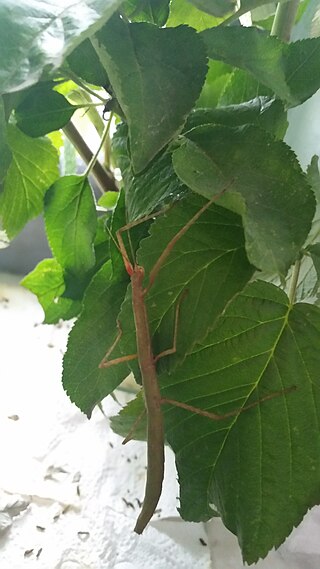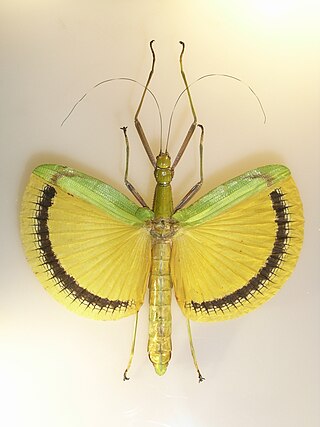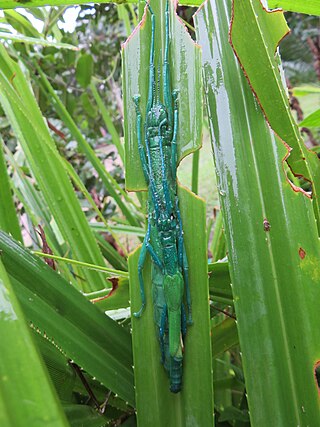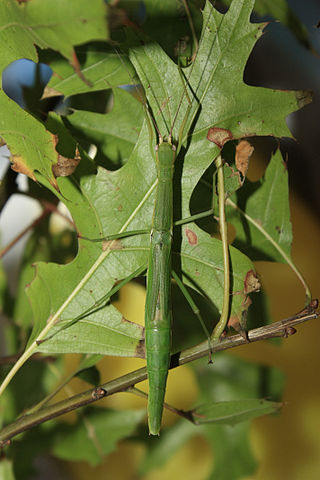
The Phasmatodea are an order of insects whose members are variously known as stick insects, stick-bugs, walkingsticks, stick animals, or bug sticks. They are also occasionally referred to as Devil's darning needles, although this name is shared by both dragonflies and crane flies. They can be generally referred to as phasmatodeans, phasmids, or ghost insects, with phasmids in the family Phylliidae called leaf insects, leaf-bugs, walking leaves, or bug leaves. The group's name is derived from the Ancient Greek φάσμα phasma, meaning an apparition or phantom, referring to their resemblance to vegetation while in fact being animals. Their natural camouflage makes them difficult for predators to detect; still, many species have one of several secondary lines of defense in the form of startle displays, spines or toxic secretions. Stick insects from the genera Phryganistria, Ctenomorpha, and Phobaeticus include the world's longest insects.

Carausius is a genus of the tribe Lonchodini, in the order Phasmatodea. The genus is in many ways typical of the Phasmatodea in that all species are twig-like in appearance. These species are parthenogenetic.

The Phasmatidae are a family of the stick insects. They belong to the superfamily Anareolatae of suborder Verophasmatodea.

Necrosciinae is a subfamily of the stick insect family Lonchodidae, with its greatest diversity in South-East Asia.
Asceles is a genus of stick insects in the tribe Necrosciini. Some of the species of Asceles have a distribution in Malaysia and Singapore.

Cryptophyllium westwoodii is a species of leaf insect in the family Phylliidae. It is distributed from southern China, the Andaman islands, Myanmar, Indo-China, Sumatra and the Riouw Archipelago.

The Clitumninae are a sub-family of stick insects in the family Phasmatidae found in Asia. The type genus Clitumnus is now considered a synonym of Ramulus.

Medauroidea is an Asian genus of stick insects in the family Phasmatidae and subfamily Clitumninae. Species have been recorded from Indo-China.

Megacrania is a genus of the subfamily Megacraniinae of stick insects. Members of this genus are commonly referred to as "peppermint stick insects", due to the characteristic odor of their defensive spray, as well as the cylindrical, twig-like shape of their bodies.

Orestes guangxiensis is a representative of the genus Orestes.

Orestes japonicus, a stick insect, is a representative of the genus Orestes.

Orestes shirakii is a species of stick insects native to Taiwan.
Entoria is a genus of stick insects in the tribe Clitumnini, erected by Carl Stål in 1875. Species have been recorded from: China, Japan, Indochina and the Philippines.
Interphasma is a genus of Asian stick insects in the tribe Medaurini, erected by S.C. Chen and Y.H. He in 2008. To date (2022), species have been recorded mostly from China, with one in Vietnam.
Neooxyartes is a monotypic genus of Asian stick insects in the tribe Necrosciini, erected by G.W.C. Ho in 2018. To date (2022) the sole species has been recorded from Vietnam.

Micadina is a genus of stick insects in the tribe Necrosciini, erected by Josef Redtenbacher in 1908. Species have been recorded from temperate and subtropical Asia, including China, Japan, Korea and Vietnam.
Paragongylopus is a genus of stick insects in the tribe Gratidiini, erected by S.C. Chen and Y.H. He in 1997. Species have been recorded from China, Thailand and Vietnam.
Macellina is a genus of stick insects in the tribe Gratidiini, erected by Boris Uvarov in 1940. Species have been recorded from China, Thailand and Vietnam.
Pachyscia is a genus of Asian stick insects in the tribe Necrosciini, erected by Josef Redtenbacher in 1908. Species have been recorded from Vietnam and China.











